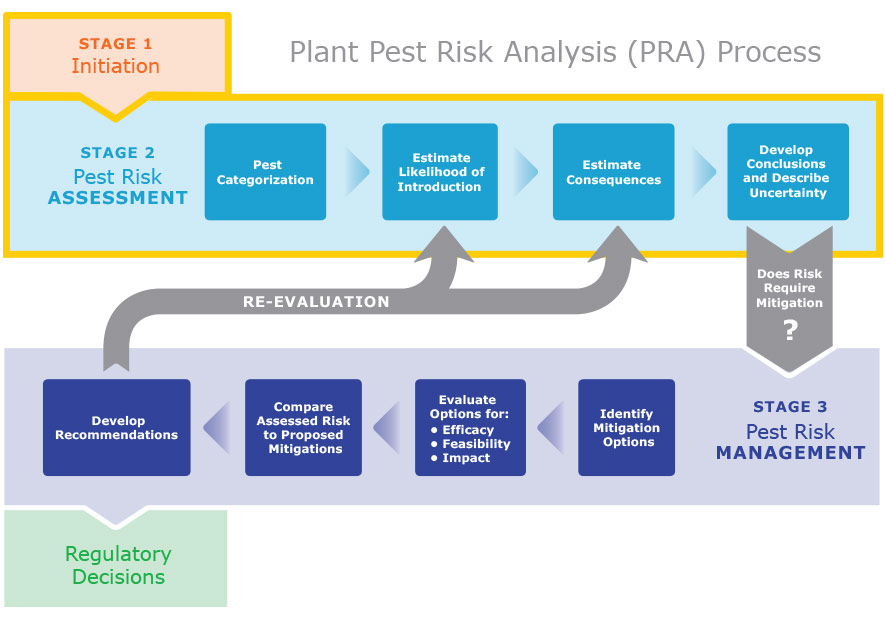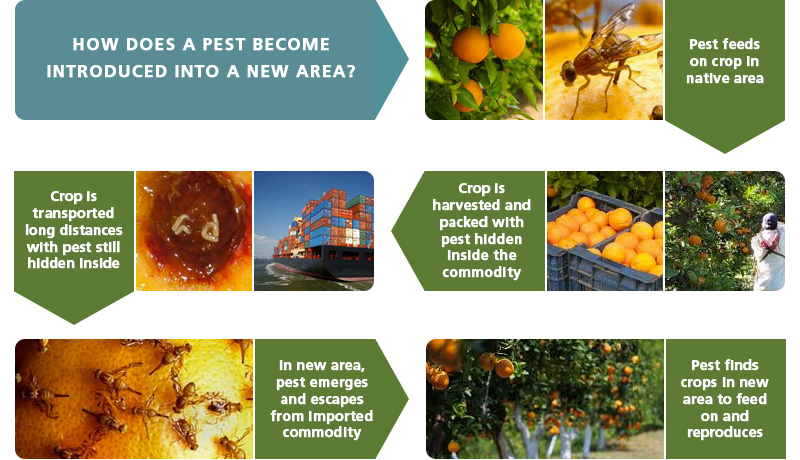Lesson 2: Pest Risk Analysis
Topic 2: Initiation and Pest Risk Assessment
This topic will help you recall the steps required to complete the first two stages of PRA—Initiation and Pest Risk Assessment.
Objectives:
- Describe the initiation stage of PRA.
- Describe the process of completing a pest risk assessment.
We will now review the first two stages for conducting a PRA: Initiation and Pest Risk Assessment. Considerable data is required for these stages of PRA. You will need data on the biology of both pests and hosts, and also data on economic impacts. Factors considered include pest presence in the importing and exporting countries, plant part(s) being traded, standard commodity handling practices, pest biology, pest and host geographic ranges, number of hosts that could be affected, climatic factors affecting establishment, and damage to both cultivated host crops and native plants in the environment.

After you have identified pest(s) during the initial data gathering exercise and defined the scope of what needs to be accomplished in the PRA, you will begin the assessment stage. The work of assessment may be undertaken in different ways depending on the type of PRA selected, such as organism, pathway, or commodity.
In this assessment stage, you will categorize the pest risk and evaluate the probability of introduction along with the resulting consequences. This involves looking at potential hazards, likelihood of hazards occurring, consequences if they do occur, and the level of uncertainty in your estimates.
Below is a list of common information with examples of the type of data often required for completing a pest risk assessment. This list is not comprehensive but is intended to illustrate the numerous and various factors that should be considered. Several ISPMs provide further guidance on collecting all of this information for pest risk assessment and throughout the entire PRA.
- Status of diseases and pests in the importing and exporting country
(E.g., in the case of declared pest-free areas, if the pest is not present in either country, there is no need to continue analysis.) - Relationship between pest and host
(E.g., mature fruit may be a host to this pest or the pest may feed exclusively on the roots of the plant.) - Relevant industry processes and production methods that could affect pathway for pest
(E.g., in the case of apples, washing and waxing in the packhouse sometimes removes the pest. Can you think of other common production and industry practices that may lower pest risks?) - Ecological and environmental conditions that could affect pest establishment
(E.g., is the climate so cold, hot, dry, or wet that the pest would not be able to survive even if it did enter?) - Potential losses to crops, the environment, and trade in the event of pest entry and spread
(E.g., which cultivated crops or wild organisms are hosts to this pest and how seriously would they be affected?) - Availability of treatments or other control measures
(E.g., which treatments are available and can actually be used to control pest? Domestic regulations may prohibit use of some chemical treatments, or access to an irradiation facility may be limited.) - Cost to control or eradicate pest(s)
(E.g., what measures can be taken in farmer’s fields, and how much will they cost?) - elative cost effectiveness of alternative approaches to limiting risks
(E.g., are there additional pest mitigation approaches that could be more feasible or more cost effective and still lower risk as much as a more aggressive approach?)
As this information is collected, keep in mind that the likelihood of an adverse event occurring usually depends on a series of events. Information for every potential event throughout the production, transport, and import/export timeline will need to be examined for risk. This is why mapping the pathway is such a valuable exercise. Mapping allows you to identify every step in the process and helps you see which steps pose pest risks. Below is one example of a potential pathway.

According to ISPM 5, after mapping the pathway to estimate likelihood of pest introduction, you must also analyze the consequences of introduction. This is typically done as part of the pest risk assessment. Remember, risk = likelihood + consequences. Here, you might consider factors like:
- Trade impacts of pest introduction.
- Which trading partners might ban your exports if the pest is introduced?
- What is the potential value of trade lost due to the banned exports?
Last, you will need to document the evidence you have collected, discoveries you made during the assessment, conclusions about what the evidence means, and the level of uncertainty involved in the conclusions. Evidence from the initiation and assessment stages will be used to indicate which pests will require measures, and the nature and strength of measures that will be required to mitigate the risk.
Your NPPO will make all phytosanitary regulatory and plant health decisions based on the conclusions of this report in combination with the pest risk management report which we review in the next topic. Therefore, it is critical that the report be accurate and current.
Initiation and Pest Risk Assessment are the first two stages in conducting a PRA, and they are the basis for making pest risk management recommendations. For more instruction, please review Module 5: Pest Risk Assessment.
To continue, select Topic 3 from the Topics menu above or click here.